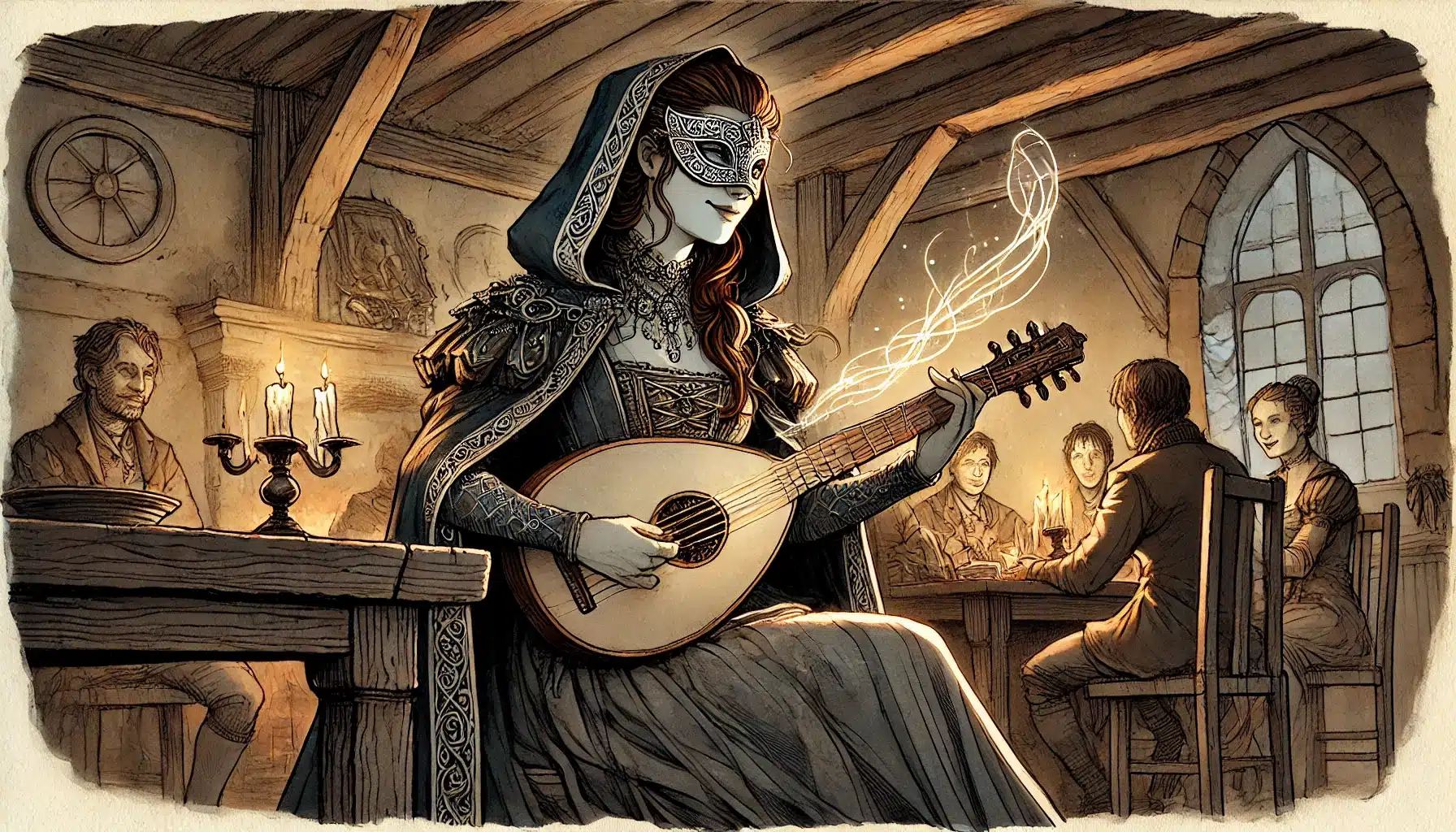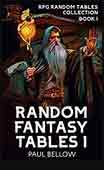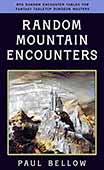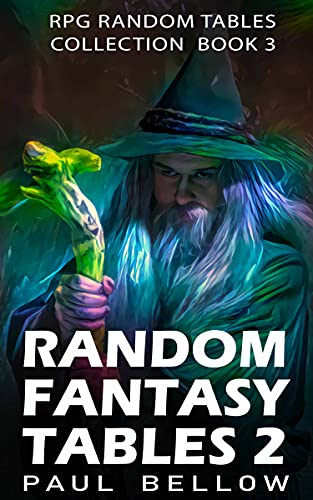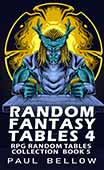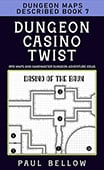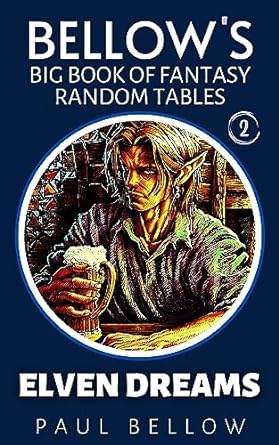Imagine a figure veiled in silk and half-truths, a stage performer who commands applause with convincing illusions—and uses the same sharp wit to sow doubt in the hearts of kings. The Bard of Lies strides onto the scene as a master manipulator, a virtuoso weaving deception, guile, and roguish charm into a seamless tapestry of intrigue. This is no mere recitation of tales; here, every uttered word is a potential weapon, every sly wink an unspoken deal. The Bard of Lies is for those who want to control not just the story, but the very perceptions of allies and enemies alike.
This homebrew class was born from a demand for something more than flash and surface-level trickery. It channels the bard’s love for drama and performance into a razor-edged toolkit of misdirection, trust-bending, and narrative manipulation, fusing the panache of the bard with the shadow-walking cunning of the rogue. Its power lies not simply in dazzling displays, but in the intricate dance between illusion and reality—always keeping others one step behind. (Check out our fantasy name generator if you want to give them a name!)
Crucially, the Bard of Lies is not content to settle for fluff. Underneath the glamorous façade is a robust chassis of mechanics expressly designed for campaigns where wordplay and double-crossing are as important as blades and spells. Its abilities provide meaningful, tactical interactivity in both battle and social encounters. A Bard of Lies can charm a dragon into a pause or spark a riot in a stuffy ballroom, with mechanics to back up every silver syllable.
This is a class built for the thoughtful trickster—a player who craves subtlety, careful deception, and creative problem-solving. While combat prowess is always close at hand, the Bard of Lies is truly in their element twisting social situations, controlling conversations, and setting the stage for allies and adversaries to dance as they wish. Think of them as narrative puppeteers, their strings expertly hidden in the folds of their cloak.
If you’re drawn to characters who bend truth into a weapon and wield stories as both shield and blade—if you savor the taste of high-stakes bluffing and thrive on pulling threads from behind the curtain—the Bard of Lies invites you to make the world your stage. Play this class if you want to elevate intrigue, turn the mundane into the extraordinary, and ensure that every moment at the table is loaded with potential.
- Origins of the Bard of Lies
- Bard of Lies Core Concept
- Mechanical Breakdown: Class Features by Level
- Signature Spells and Magical Flair
- Roleplaying the Bard of Lies
- Building a Bard of Lies Character
- Bard of Lies in Combat
- Bard of Lies in a Party
- DM Tips for Running with a Bard of Lies
- Player Challenges and Pitfalls
- Advanced Bard of Lies Variants
- Variant Subclasses or Archetypes
- Lore Hooks and World Integration
- Final Thoughts on the Bard of Lies
Origins of the Bard of Lies
The Bard of Lies is rooted in the timeless myth of the trickster—the silver-tongued deceivers, spies in masquerade, and wheeler-dealers who’ve always been the shadow-side of adventure stories. Figures like Loki, Anansi, and Odysseus served as touchstones: heroes (or antiheroes) whose greatness sprang as much from cunning plots as from raw power. Early brainstorms circled around the tension between artistry and deception, the idea that performers could be more dangerous than swords.
Try my AI Tabletop RPG generators...and an extensive library of content!
Mechanically, the Bard of Lies emerged from a felt need: traditional bard subclasses are excellent at inspiration, eloquence, or unsettling whispers, but none fully embraced the art of the con. There was a vacant niche for a class that sits at the crossroads of support and subversion—someone who could support their allies by destabilizing enemies and rewriting reality’s very script. Existing archetypes dabbled, but the Bard of Lies is wholly dedicated to this idea: a bard who makes the world dance to their tune, whether through pure talent or arcane trickery.
Designing the Bard of Lies was an intricate, collaborative process, with designers, GMs, and playtesters lending their experience. The earliest versions experimented with mechanics lifted from both bards and rogues, carefully balancing the social and mechanical impact of deception. Questions abounded: How far can a player push the narrative with a lie? Should illusions be more than visual tricks? Playtesters quickly fell in love with the class’s flexibility, especially in social-rich campaigns.
Feedback and iteration proved invaluable. Early abilities that felt too “passive” were swapped for flashier, risk-reward features; spells originally borrowed whole-cloth from illusion schools were re-flavored and mechanically tweaked. Through it all, the guiding philosophy remained clear: every power had to tell a story, every feature needed to give the player actual agency—not just in combat, but in the twists and turns of the campaign’s plot.
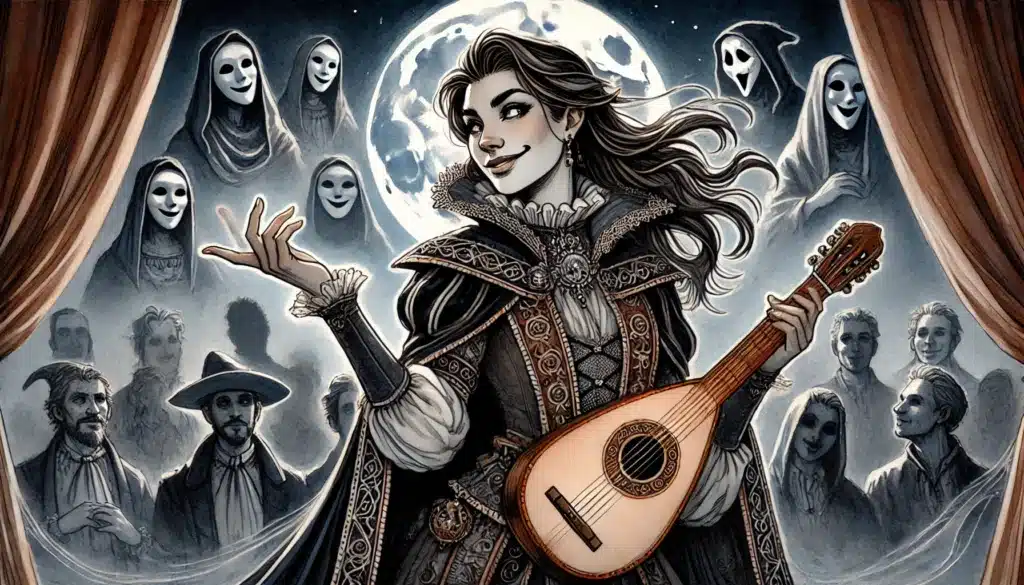
Bard of Lies Core Concept
At its rotten apple core, the Bard of Lies is an artist with reality as their canvas—a social savant who bends perception, inspires doubt, and manipulates emotions with every gesture and syllable. They aren’t just liars; they’re illusionists, provocateurs, and unsung puppetmasters as comfortable on the battlefield as in the ballroom. Every performance is a gamble, every interaction a chance to alter fate.
⚔️ Fantasy RPG Random Tables Books
Make life as a Gamemaster easier…
If you play Dungeons & Dragons, Pathfinder, or other fantasy RPGs, this
RPG random tables series
is packed with encounters, NPCs, treasure, and more. Available in eBook or print—either way, you’ll have a wealth of adventure ideas at your fingertips.
Unlike the College of Whispers, who sow fear and paranoia through psychic intimacy, or the College of Eloquence, whose persuasive prowess outstrips all rivals, the Bard of Lies goes much further. Their unique blend of arcane trickery, stagecraft, and roguish sleight-of-hand lets them warp not only what people believe, but what they experience. If the College of Eloquence is a master orator and Whispers is a manipulative terror, the Bard of Lies is a world-class forger—with reality as their signature work.
Bard of Lies characters thrive on ambiguity. Where others inspire trust, they plant seeds of suspicion; where others smooth over conflict, they conjure compelling distractions, red herrings, and outright falsehoods as needed. The class rewards players who love ambiguity—working from the shadows, orchestrating plans within plans, and making every word do as much work as possible.
Not sure how to bring this archetype to life? Here are key motifs and traits for the Bard of Lies:
- Mask-wearing con artist
- Truth-bending poet
- Shadow diplomat
- Illusionist provocateur
- Emotion-forging balladeer
- Double-agent with a taste for theatrics
- Scoundrel with a thousand faces
- Velvet-tongued imposter
- Propagandist with arcane tools
- Memory-twisting storyteller
- Disguise virtuoso
- Riot-inciting loved one
- Sock-puppet whisperer
- Fortune-telling manipulator
- False prophecy bard
- Schemer who exploits superstition
- Harlequin of hidden agendas
- Jester wielding deadly rumors
- Chronicler who edits the present
If you’re the type who wants to direct both the action and the plot—if you crave opportunities to steer the narrative and control chaos—the Bard of Lies will feel like home. The class is ideal for campaigns brimming with intrigue, courtly scandal, or shadowy organizations, for those who want to tum social schemes into high drama and always have an ace up their sleeve.
Playing the Bard of Lies means living in the space between what’s real and what’s believed. Whether you’re orchestrating a daring caper, toppling a corrupt regime, or simply ensuring your friends see the brighter (or more advantageous) version of events, you’ll shape both story and struggle. Truth itself is your greatest tool—and your most dangerous enemy.
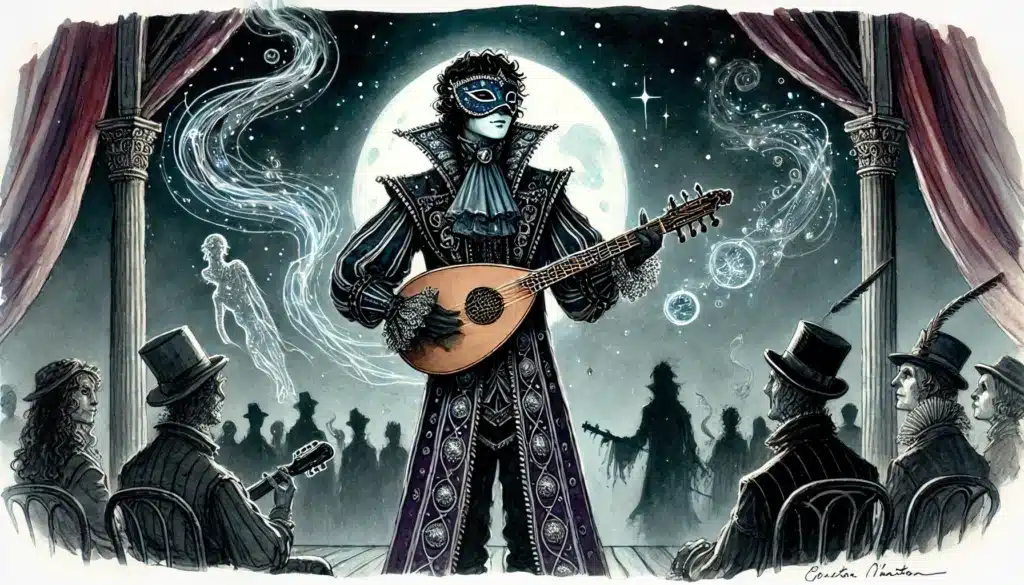
Mechanical Breakdown: Class Features by Level
The Bard of Lies advances through a web of features that blend rogue-like deception with the spellcasting prowess of a bard. At first, you’re a master of small cons and subtle misdirection; by 20th level, you wield stories as weapons, staging full-blown reality-warping spectacles. Key features grant you tools for both overt manipulation and subtle influence, rewarding cunning and creative thinking as highly as direct confrontation.
From level one, features like Silver Tongue and Mask of Many Lies give you advantages in social maneuvering and the ability to pass yourself off as anyone, anywhere. As you progress, your magical and mundane deceptions become more potent, allowing for battlefield control through illusions and mind-altering performances. You turn simple lies into game-altering gambits—faking deaths, sowing chaos, and even rewriting memories.
Every few levels, you gain new twists: ways to further muddy the waters, bolster your allies’ deceptions, or spin stories so elaborate they ensnare even seasoned adversaries. Your skills in persuasion, insight, and performance grow in step with your magical mastery, letting you skirt the edges of belief—and make others do your bidding, whether they realize it or not.
Below is a comprehensive outline of signature features by level:
| Level | Key Feature | Description |
|---|---|---|
| 1 | Silver Tongue | Gain proficiency & expertise in Deception and Persuasion. |
| 2 | Phantom Verse | Use Bardic Inspiration to plant false memories or ideas. |
| 3 | Mask of Many Lies | Change appearance and voice at will; limited shapechanging. |
| 4 | False Identity | Craft flawless backstories and documents; fool magic tests. |
| 5 | Subtle Saboteur | Advantage on Sleight of Hand; can plant evidence unnoticed. |
| 6 | Encore of the Forgotten | Infect multiple targets with a fabricated group memory. |
| 7 | Unreliable Narrator | Twist or negate witness testimony with a reaction. |
| 8 | Slip the Noose | Automatic escape from non-magical restraints; vanish briefly. |
| 9 | Shadow Performance | Cast silent/illusory performances in zones of dim light. |
| 10 | Lies Become Truth | Enchant targets so they act on your spoken “truth.” |
| 11 | Master of Masks | Instantly adopt any persona, gaining 1 trait/skill temporarily. |
| 12 | Web of Doubt | All enemies nearby make Insight saves with disadvantage. |
| 13 | Rumor Monger | Incite riots or rally crowds with a performance. |
| 14 | Rewrite Fate | Rewrite one recent event per long rest (DM adjudication). |
| 15 | Shroud of Misdirection | Allies can disappear into illusions as a reaction. |
| 16 | The Grand Ruse | Cast Major Image as a bonus action, no components. |
| 17 | Dispel Reality | Once per short rest, negate one spell or effect by “disbelieving.” |
| 18 | Puppet Master | Dominate Person disguised as an irresistible idea or suggestion. |
| 19 | Lie Eternal | Automatically revive from unconsciousness once per long rest. |
| 20 | The Final Bow | Once per campaign/session, dictate outcome of a dramatic event. |
The Bard of Lies rewards clever improvisation as much as rules mastery. Players are encouraged to wield their abilities in unexpected ways—using illusions as distractions, roleplaying fabricated personas, or orchestrating high-stakes cons. Experience with the class means learning to see every situation as an opportunity, and every enemy as a potential dupe or ally in disguise.
Those who stick with the class will find themselves at the center of almost any narrative, their webs of lies providing fertile ground for roleplay, political maneuvering, and creative problem-solving. The features don’t just add numbers—they open new doors, turning each session into a stage for player-driven intrigue.
Signature Spells and Magical Flair
Spellcasting with the Bard of Lies is nothing like standard issue bardic magic. Your spells are tools designed to confuse, mislead, alter perception, and cement your power as a magical manipulator of reality. From low-level sleights to full-scale audience hallucinations, each spell is an instrument in your symphony of deception.
The Bard of Lies spell list is carefully curated for maximum narrative flexibility and misdirection. Some are renamed classics, dripping with thematic flavor; others are custom creations designed to fit the archetype like a fine glove. The focus here is on spells that twist minds, conceal truths, amplify emotions, incite mobs, or create cunning illusions. Their power lies not in flash or destruction, but in utility and surprise.
⚔️ Fantasy RPG Random Tables Books
Make life as a Gamemaster easier…
If you play Dungeons & Dragons, Pathfinder, or other fantasy RPGs, this
RPG random tables series
is packed with encounters, NPCs, treasure, and more. Available in eBook or print—either way, you’ll have a wealth of adventure ideas at your fingertips.
You won’t find endless direct damage on your list—instead, you’ll discover how much chaos you can instigate by making someone believe a friend is an enemy, or by spinning an entire scenario from nothing but words. Many Bard of Lies spells are open-ended, encouraging collaboration with the DM to make each use unique and memorable.
Here are some signature spells for this class:
- Mirage Narrative (Disguise Self)
- Ghost Applause (Unseen Servant)
- Echo of Doubt (Dissonant Whispers)
- Stage Fright (Fear)
- Scripted Recall (Modify Memory)
- Shifting Spotlight (Mirror Image)
- Glamour of Guilt (Phantasmal Force)
- Whispered Rumors (Sending, but always heard as a secret)
- Thunderous Laughter (Hideous Laughter, forces audience to join in)
- Doubled Identity (Alter Self, but doubles as a voice mimic)
- Falsify Evidence (Illusory Script, works as physical evidence)
- Curtain Call (Silent Image, persistent as long as you perform)
- Entrancing Slander (Suggestion, triggers on insults or flattery)
- Profane Oath (Compel Duel, but with the stakes of social challenge)
- Unmasking Gleam (See Invisibility, but reveals lies and disguises)
These spells bring the illusionist trickster fantasy to life—tools to upend expectations and reforge the tension of every encounter. Importantly, the class’s contributions are kept in balance by (1) the need for roleplay and smart strategy, and (2) judicious spell slot management.
Spell versatility is the central pillar of the Bard of Lies. Their magic is never just about causing an effect; it’s about creating moments and opportunities—narrative launches for the party to exploit, or ingenious getaways for the bard alone. Every spell is a chance to shape the world’s perceptions, and in the process, become legend.
Roleplaying the Bard of Lies
To play the Bard of Lies is to embrace duality. The class embodies both the charisma of the ultimate performer and the shadowy edge of the consummate deceiver. Lean into that contradiction—portray a character with a dazzling public face, but underneath, layers upon layers of calculated duplicity or secret motivations.
A Bard of Lies’ speech is artful and intoxicating, shifting between poetic flourishes, pointed sarcasm, subtle innuendo, and piercing, tactical parsimony. Every conversation is a performance—whether you’re dazzling a room with oratory, feeding crumbs of half-truth to an informant, or comforting an ally with a “necessary” fabrication. Your character should be impossible to fully grasp.
Bringing this class to life means thinking like an author as much as a player: layering clues, preparing alibis, and always having an ulterior motive. Give your bard a signature mannerism—perhaps a habitual touch of their mask, a secret code embedded in stories, or a knowing glance that only certain companions recognize. Develop elaborate cover stories, alternate identities, and fallback personas.
Need ideas for Bard of Lies roleplay?
- Changing names and accents seamlessly
- Adopting multiple secret or public identities
- Lying “for the good of the party”
- Crafting intricate cover stories for each new town
- Performing in disguise to test a theory or gain information
- Planting rumors before the party arrives in a city
- Delivering “prophetic” songs whose truth is uncertain
- Befriending NPCs as different people
- Writing anonymous political satires or libelous songs
- Leaving cryptic notes, signed with a symbol or riddle
- One-upping party stories with “better” (fabricated) tales
- Refusing to remove their mask in public
- Using sleight-of-hand for harmless practical jokes
- Faking divinations or using “signs from the gods” to sway decisions
- Orchestrating elaborate ruses during downtime
- Lying about their background, even to themselves
- Secretly sabotaging (or aiding) rivals through misinformation
Encourage your DM and group to play along! The emotional journey of a Bard of Lies can be deep—explore why your character embraces deception. Are they protecting themselves? Hiding past traumas? Do they tell themselves it’s all for a noble cause, or do they simply love control? Lying isn’t just a tool for survival in this class; it becomes a lens for self-examination and drama.
Try my AI Tabletop RPG generators...and an extensive library of content!
Ultimately, the Bard of Lies is more than a manipulator: they are a cipher, a mystery even to their closest allies, the thread that binds and sometimes unravels the tale. Savor the chance to create a legacy that’s as much legend as truth.
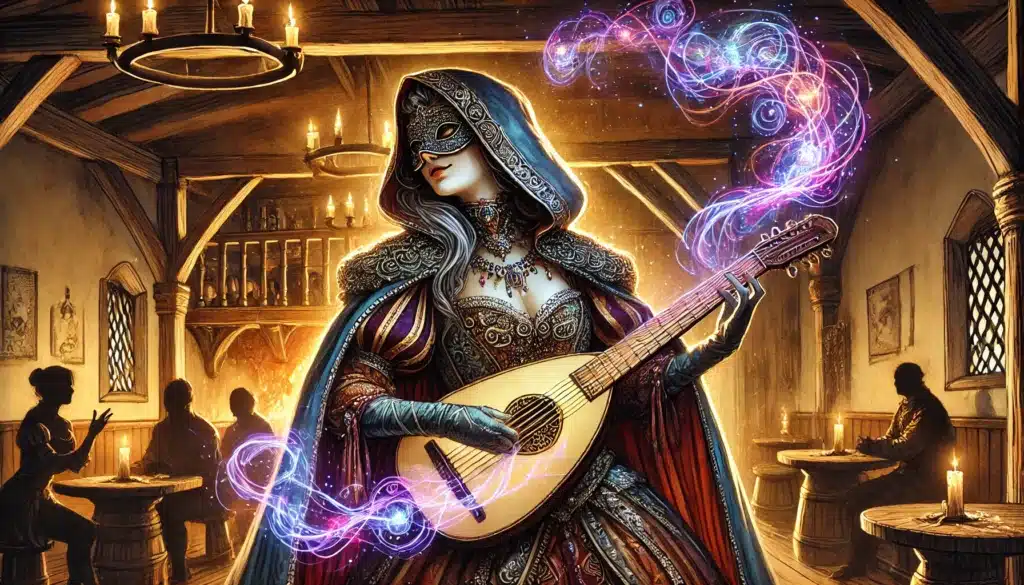
Building a Bard of Lies Character
Optimizing a Bard of Lies means balancing your love of subterfuge with the mechanical depth of D&D. Multiclassing is an obvious draw—Rogue for sneak attacks and expertise, Warlock for eldritch invocations and extra spells, or Sorcerer for metamagic tricks. Even a single level in another class can open up whole new layers of deceit and narrative power.
Feats can make a world of difference. The Actor feat, of course, but also things like Skilled (for more proficiencies), Observant (for keen perception), or Inspiring Leader (to motivate through half-truths). Pairing races with Charisma, Dexterity, or unique features—such as Half-Elf’s versatility or Changeling’s shapeshifting—amplifies your toolkit.
Backgrounds are your bread and butter. Charlatan, Spy, Entertainer—anything that lets you justify your web of contacts, alternate identities, and narrative hooks. Don’t just think of numbers—build a person with a storied past and a tangle of obligations, secrets, and debts.
Here are sample builds:
| Build Type | Suggested Race | Recommended Feats | Strategic Strengths |
|---|---|---|---|
| Social Manipulator | Half-Elf | Actor, Inspiring Leader | Versatility, leadership |
| Urban Spy | Changeling | Observant, Skilled | Disguise, infiltration |
| Phantom Troubadour | Tiefling | War Caster, Shadow Touched | Spellcasting, mystique |
| Poisoned Poet | Human (Variant) | Lucky, Skulker | Stealth, luck |
| Con Artist | Halfling | Actor, Alert | Surprise, evasion |
| Riot Inciter | Satyr | Fey Touched, Inspiring Leader | Crowd control, mobility |
| Smiling Assassin | Eladrin | Mobile, Resilient | Mobility, social blade |
| Memory Forger | Gnome (Forest) | Skilled, Lucky | Memory spells, craftiness |
| Face in the Crowd | Kenku | Prodigy, Observant | Mimicry, blending in |
| Diplomat’s Nightmare | Yuan-Ti | Magic Initiate, Actor | Resistance, charm immunity |
Remember: the best Bard of Lies is one that fits your group’s dynamic. Don’t chase raw power—chase opportunity. Think about how you can use your talents not just to win, but to create unforgettable moments at the table.
Versatility is your watchword; creativity, your most reliable weapon. The Bard of Lies will always be as successful as you are inventive—spinning webs, spinning yarns, and always making the party wonder what’s truly real.
Bard of Lies in Combat
While the Bard of Lies isn’t a frontline bruiser, they’re a nightmare for anyone relying on clarity, communication, or predictable action. You specialize in turning confusion into chaos: disrupting enemy attacks, making foes doubt their senses, and controlling the pace of battle with illusions and careful misdirection.
Expect to use magic and skills in tandem—pairing a strategic Suggestion or Hypnotic Pattern with a quick lie to send enemies stumbling or allies slipping past undetected. You’re the master of clever feints, using your words and spells to create momentary openings. If direct violence is needed, you’ll rarely fight fair—opting for sabotage, secret signals, and opportunistic strikes.
Your primary weapon? Doubt. You’ll force enemies to question their allies, their own perceptions, and even what just happened. This turns every skirmish into a dramatic set piece, with the Bard of Lies always three steps ahead—hiding, striking, and vanishing when least expected.
Combat Tactics and Strategy
In the thick of battle, the Bard of Lies is the champion of feints and diversions. Control initiative with quick wits and illusions, confusing rival spellcasters and redirecting attacks at key moments. Disguise damage as someone else’s doing, or make allies seem far more threatening than reality.
Don’t be afraid to fake weakness, collapse at the right time, or bait enemies with a well-timed “mistake.” Leverage your environment—cast illusions that provide cover, turn enemies against one another with cunning words, or use the chaos of combat as the backdrop for your next caper.
Here are some mid-battle deception tactics:
- Fake a critical injury to draw attention away from an ally
- Cast an illusion of an ally, causing enemies to waste attacks
- Use “fake” spellcasting gestures as a bluff (draw fire or interrupt)
- Hide a weapon under an illusion, then strike at surprise
- Feign surrender, then cast a surprise spell
- Incite enemy confusion with conflicting orders in their language
- Plant illusory traps to lead foes astray
- Hide unconscious allies within illusory debris
- Force enemies to attack each other through disguised Suggestion
- Plant false evidence of ambushes or reinforcements
- Throw your voice to simulate reinforcements arriving
- Vanish in a puff of illusory smoke—then attack from behind
- Drop hints (“secret” signals or codes) to cue the party for coordinated strikes
Playing the Bard of Lies means thinking of every combat round as a fresh stage. Each turn is a spotlight moment—will you mislead, escape, or orchestrate a group deception leading to victory?
DMs and players alike should embrace cinematic moments: explosions of illusory pyrotechnics, dramatic feints, and crowd-baiting stunts. Allow the Bard of Lies—when played with flair—to redefine what victory looks like in a heroic struggle, making every fight unique and memorable.
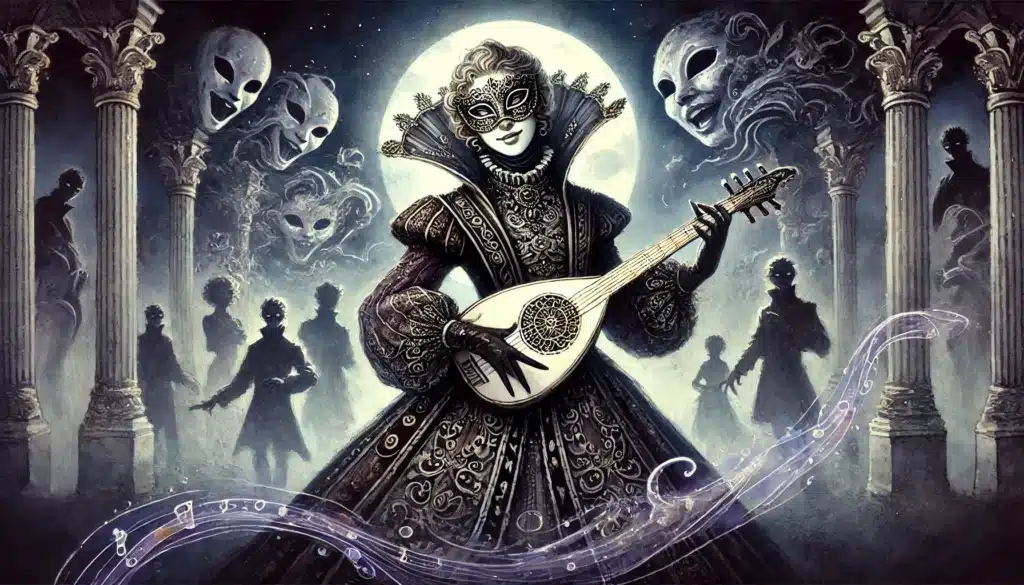
Bard of Lies in a Party
The Bard of Lies isn’t just a solo act—they shine brightest in high-chaos parties, intrigue-laden campaigns, or mixed-motive adventuring groups. They’re natural glue for groups with conflicting aims, acting as peace-keeper, secret-keeper, or instigator depending on the needs of the moment.
The class elevates group play by supporting face characters with surprises, protecting stealth specialists, and turning the party’s weaknesses into strengths by spinning confusing stories or manufacturing alibis as needed. The Bard of Lies can set up both narrative payoffs and combat combo moves, giving them a unique niche both in and out of fights.
Looking for ideal party synergies?
- Paladin: The “foil of honesty” for dramatic tension
- Sorcerer: Magical showmanship duos, amplified illusions
- Warlock: Shared dark secrets, two-tier manipulations
- Rogue: Twin deception, coordinated cons and diversions
- Cleric: Ethical debates, divine-truth tension
- Barbarian: Brute force + subtlety = classic team chaos
- Wizard: Joint research into forbidden or illusion magics
- Ranger: Information-gathering, long cons in the wild
- Artificer: Trick gadgets for performance and trickery
- Monk: “Good cop, bad cop” in interrogation or crowd scenes
- Druid: Nature-based disguises and illusion tricks
- Fighter: Straight man to your comic foil
- Bard (College of Lore): Counterpoint for secrets-vs-knowledge
- Another Bard of Lies: Rivalry, mentor/student, or “double agent” team
The Bard of Lies balances narrative impact with mechanical utility, always offering a supporting role, plot engine, or chaos vector whenever the party needs a new twist. Don’t be afraid to step into the role of story-catalyst or comic relief—your toolkit is built for it.
⚔️ Fantasy RPG Random Tables Books
Make life as a Gamemaster easier…
If you play Dungeons & Dragons, Pathfinder, or other fantasy RPGs, this
RPG random tables series
is packed with encounters, NPCs, treasure, and more. Available in eBook or print—either way, you’ll have a wealth of adventure ideas at your fingertips.
Ultimately, this class can slot into almost any campaign, provided the group enjoys intrigue, layered plans, or dramatic reversals. It’s the seed of a hundred future legends—or scandals—waiting to unfold.
DM Tips for Running with a Bard of Lies
Dungeon Masters running campaigns with a Bard of Lies in play have the privilege—and challenge—of supporting their player’s craftsmanship while keeping the world internally consistent. Lean into the class’s desire for narrative power, but keep a wary eye on balance… not every lie should succeed, and not every illusion should go unexplored.
Be generous with social and deception checks, but craft meaningful consequences for failed gambits. Tie illusion mechanics to in-world physics and NPC capabilities; sometimes, the best lie is the one that only works “just well enough.” Encourage player creativity—reward wild plans, but make success thrilling by letting failure have weight.
Ways DMs can build around the Bard of Lies:
- Include morally ambiguous or grey NPCs
- Use social puzzles that reward clever wordplay
- Feature lie-sensitive magical wards or artifacts
- Add rumors and intrigue-driven quests
- Create lie-detecting monsters and challenges
- Provide opportunities for double or triple-crosses
- Design rival con artists, spies, or liars
- Fill courts with secret societies and layered politics
- Use downtime for elaborate cover stories to pay off later
- Integrate magical consequences for exposure or failed cons
- Make Deception useful for bypassing magical traps
- Let illusions interact physically (with risk)
- Offer “liar’s tools” as unique magic items (masks, quills, etc.)
- Introduce story arcs about truth, trust, and identity
- Build dramatic twists on player-sown rumors
A Bard of Lies at your table is a story engine—fuel them with secrets, give them rivals, and let their victories be hard-won. Just as importantly, let the stakes feel real: friendships, reputations, and even lives can be on the line.
Remember: the class works best when clever play is rewarded, but the curtain can always drop. Let your Bard of Lies change the story, but charge them a price when they gamble too boldly. A world that bends for lies—yet bites back—makes every performance unforgettable.
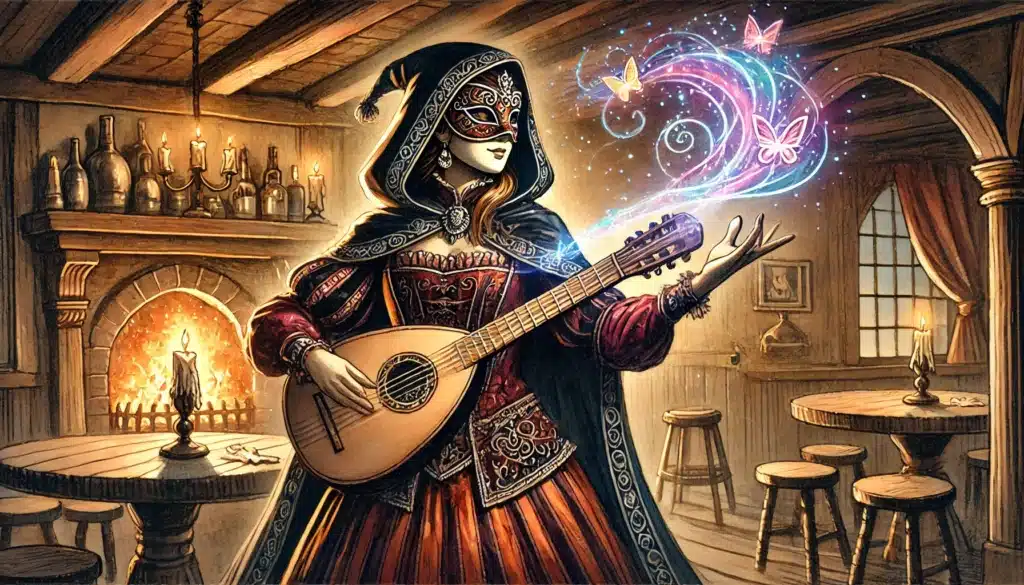
Player Challenges and Pitfalls
No class built on duplicity comes free of risk. Bard of Lies players can run into trouble with group cohesion—chronic lying may alienate allies, muddle party objectives, or slow pacing with overlong cons. Meta-conflicts can crop up too, when the player’s secrets bleed into player-to-player trust.
Watch out for the classic pitfalls:
- Lying so often that party trust collapses
- “Stealing the spotlight” by dominating social scenes
- Creating confusion in group plans or objectives
- Drawing too much DM attention for overcomplicated schemes
- Misjudging NPC reactions (or overusing Deception checks)
- Slowing down play by “over plotting” or stalling
- Forgetting to leave room for allies’ contributions
- Feeling powerless when your lies don’t land
- Breaking party immersion with out-of-character explanations
- Using illusion magic as a solve-all instead of a tool
Navigate these issues with clear communication. Always check in with the group if you’re about to run a big con, and make sure your deception serves the collective narrative—not just your own. Share the spotlight; let your ruses set up wins for your friends as often as for yourself.
Above all, embrace the “yes, and” principle—always use your trickery as a springboard for party drama, not a barrier. When conflict arises, lean into it as a driver for new stories and new relationships. A Bard of Lies is only as fun as the trust they build—even if it’s built on artful, mutually agreed-upon deception.
Advanced Bard of Lies Variants
Not every campaign calls for the same brand of duplicity. The Bard of Lies is wonderfully modular—tweak subclasses, swap motifs, or remix archetypes to tailor the experience to your table. Do you want more stealth? Focus on manipulation of memory? Lean into fear, or ride the line between comedy and menace? It’s all possible.
Some campaigns might demand a more sinister take, with psychological horror and paranoia reigning supreme. Others might celebrate the pure showmanship of trickery, or even tie the class’s powers to supernatural, fey, or necromantic origins. Consider the flavor that fits your world best!
Advanced homebrew options allow you to create Bard of Lies subclasses with wildly different personalities, specializations, and narrative hooks—each with unique mechanics and features, ready for play or adaptation.
Variant Subclasses or Archetypes
Remix ideas to suit specific playstyles:
- College of Masks: Focus on disguise, persona-crafting, and face-changing magic.
- College of Shadowsong: Combine musical enchantment with “stealth spells” and quiet movement.
- College of Trickery: Classic pranks, misfortune, and chaos magic.
- College of Forgotten Truths: Alters or erases memories at will.
- College of the Phantom Harlequin: Controls fear, laughter, and mass emotional swings.
- College of the Doppelganger: Shapechanger specialist, master of mimicry.
- College of Midnight: Embraces darkness, shadow illusions, and sinister deals.
- The Masquerader’s Oath: Swears allegiance to a deity of lies, gaining divine boons.
- College of the Deathmask: Talks to ghosts, forges “final” stories for the restless dead.
- College of the Nightingale: Focuses on rumor-mongering, blackmail, secret whisper networks.
Each subclass brings its own mechanics and storyline invitations. Some favor combat with new magical effects, while others lean heavily into roleplaying with unique social or narrative twists.
Homebrew DMs: customize, merge, and invent to fit your campaign’s flavor! Maybe the Bard of Lies’ powers originate with a Fey patron, or their masquerade is a requirement of a strange magical order. Tweak the spell list or signature features to dial the power level and narrative focus exactly where you want it.
Lore Hooks and World Integration
Fitting the Bard of Lies into your campaign world opens a treasure trove of possibilities. Connect them to ancient trickster cults, forbidden colleges, or legendary performers who shaped history with more rumor than fact. There’s room for cultural reverence, religious devotion, or even official persecution depending on your campaign’s tone.
Consider embedding their magic in the politics and mythos of your setting. Maybe there’s a festival celebrating divine lies, or a shadowy bardic college operating from behind illusory facades. Make the class a lightning rod for story hooks, adventure arcs, and character drama.
Lore seeds to try:
- Patron deity of lies, secrets, or stories
- A bardic college hidden by centuries-old illusions
- Forbidden art taught by an immortal trickster
- Tales of the “First Mask,” a legendary Bard of Lies who toppled kingdoms
- Con artist’s guild with magical initiation rites
- Rogue state whose leaders are all Bard of Lies alumni
- Enchanted masks as artifacts, each with a rumor-laden history
- Sacred day where all lies are considered truth
- Cultural taboo against certain musical instruments—believed to incite deception
- Rival bardic traditions (truth-tellers vs. liars)
- An extradimensional archive of stories, accessible only to skilled deceivers
- A ghostly bard rumored to haunt performances, offering power for a price
Strong world integration doesn’t just ground the Bard of Lies—it makes every lie, rumor, and con ripple out to influence the setting’s fate. It transforms the class from a player’s toolbox into a campaign’s engine of drama.
Players and DMs should collaborate to build these connections. When a class’s backstory and abilities are woven into the gameworld, every session gains new narrative resonance and possibilities for legendary deeds.

Final Thoughts on the Bard of Lies
The Bard of Lies is not just a class—it’s a canvas for the audacious, the mischievous, and the narratively ambitious. It brings together the best of bardic magic and rogue’s cunning, demanding both high creative engagement and a willingness to blur the boundaries of reality itself. Its strengths are legion: deceptive power, narrative influence, battlefield misdirection, and social dominance, all wrapped in panache.
This is a class that rewards players who think two steps ahead and delight in outsmarting both their enemies and their friends (with consent). Every feature and spell is an invitation to create something unique—an encounter, a mystery, a memorable turn of phrase that will be retold long after the campaign ends.
The Bard of Lies is, admittedly, not for every table. Its best moments require trust, thoughtful collaboration, and DMs who revel in intrigue and player-driven chaos. In less roleplay-focused groups, or with players unused to subtlety, its powers may seem niche or even destabilizing. But given the right context, it turns every campaign into a story worth telling.
So test, tinker, and transform as needed—every group deserves their own take. Push the boundaries of deception, of performance, and of what it means to “win” an encounter. Let the Bard of Lies make your stories richer, your battles cleverer, and your alliances deliciously fraught with possibility.
Try my AI Tabletop RPG generators...and an extensive library of content!
⚔️ Fantasy RPG Random Tables Books
Make life as a Gamemaster easier…
If you play Dungeons & Dragons, Pathfinder, or other fantasy RPGs, this
RPG random tables series
is packed with encounters, NPCs, treasure, and more. Available in eBook or print—either way, you’ll have a wealth of adventure ideas at your fingertips.
Ready to step into the limelight—mask on, truth in your pocket, and a standing ovation always one lie away? The Bard of Lies waits in the wings, eager for their cue. Take the stage, and make history.

